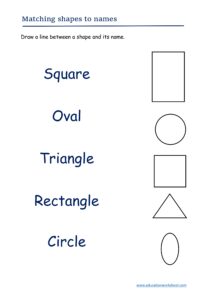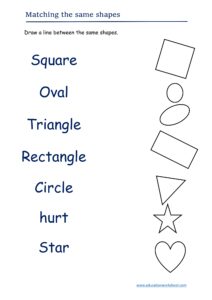Match shapes and their names
-
Match shapes and their names
- The objective of this activity is to enhance visual recognition and reinforce the understanding of basic geometric shapes and their corresponding names. It’s an educational exercise suitable for children, students, or anyone looking to brush up on their geometry skills.
Materials Needed:
- Shape Cards: Prepare a set of cards, each featuring a different geometric shape. The shapes can include circles, squares, triangles, rectangles, pentagons, hexagons, octagons, ovals, rhombuses, and trapezoids. These cards should be large and colorful to attract attention and make the shapes easily distinguishable.
- Name Cards: Create a set of cards with the names of the shapes written clearly and legibly. Ensure that the font is easily readable and matches the shape cards. Use different colors or fonts to make the name cards visually distinct from each other.
- Playing Surface: You can use a table, a flat surface, or a wall as your playing area. Ensure it’s large enough to accommodate all the shape and name cards.

Match shapes and their names
Instructions:
- Set Up: Lay out all the shape cards face up in a random arrangement on the playing surface. Make sure they are spread out so they can be easily seen and reached.
- Matching: In this activity, participants are tasked with matching each shape card to its corresponding name card. They do this by physically picking up a shape card and identifying its name from the name cards available. Once they think they’ve found the correct match, they place the shape card next to or on top of the corresponding name card.
- Discussion: Encourage participants to discuss their choices and reasoning as they make matches. This promotes a deeper understanding of the properties of each shape and helps reinforce the connection between the shape and its name.
- Variations: To make the activity more challenging, you can introduce more complex shapes or include shape attributes (e.g., number of sides, angles, or whether it’s regular or irregular) on separate attribute cards that participants must also match.
- Scoring (Optional): If you want to add a competitive element, you can assign points for each correct match and keep a score. This can make the activity more engaging for individuals or teams.
Benefits:
- Educational: This activity is an effective way to teach and reinforce the recognition of geometric shapes and their names.
- Cognitive Development: It enhances cognitive skills such as visual recognition, memory, and problem-solving.
- Communication: Encourages communication and collaboration when participants discuss their choices and reasoning.
- Engagement: The colorful and hands-on nature of the activity makes it engaging and fun for learners of all ages.
- Customization: You can adapt the activity’s complexity to suit different age groups or learning levels.

Match shapes and their names - Match shapes and their names
Conclusion: “Match Shapes and Their Names” is an interactive and educational activity that combines visual learning with hands-on engagement. It’s a versatile tool for educators, parents, or anyone interested in promoting geometric understanding and cognitive development.
Of course! Let’s match some shapes with their names:
Circle – O
A round shape with no corners or edges.
Square – []A four-sided shape with equal sides and right angles.
Triangle – ΔA three-sided shape with three angles.
Rectangle – [ ]A four-sided shape with opposite sides of equal length and right angles.
Pentagon – ⬟A five-sided shape with five angles.
Hexagon – ⬢A six-sided shape with six angles.
Octagon – ⯁An eight-sided shape with eight angles.
Oval – ()A rounded shape that is elongated like an egg.
Rhombus – ◇A four-sided shape with all sides of equal length but with opposite angles not necessarily equal.
Trapezoid – ⏢A four-sided shape with two parallel sides.
I hope this helps you match shapes with their names! If you have any more questions or need further assistance, feel free to ask.

